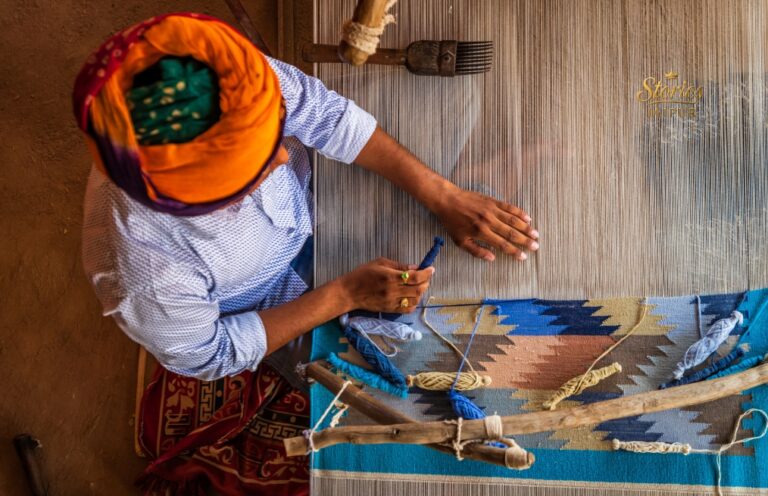Rajasthan, a land steeped in history and vibrant culture, boasts a textile tradition as rich and colourful as its landscapes and people. For centuries, the looms of Rajasthan have been alive with the rhythmic clatter of creation, weaving threads of tradition into stunning fabrics and distinctive styles that continue to captivate the world. From the simplest cotton prints to the most opulent silk brocades, Rajasthani textiles are a testament to the enduring skill and artistry of their craftspeople.
The Magic of Block Printing
One of the most iconic textile traditions of Rajasthan is block printing. Using hand-carved wooden blocks, artisans painstakingly stamp intricate patterns onto fabric, creating vibrant and unique designs. Techniques such as Sanganeri and Bagru printing, originating from villages near Jaipur, are renowned for their distinctive motifs and colour palettes, often featuring floral patterns, geometric designs, and natural dyes. This time-honoured process results in textiles that possess a distinct artisanal charm and a deep connection to the land.
The Allure of Tie-Dye: Bandhani and Leheriya
Rajasthan is also celebrated for its exquisite tie-dye techniques, most notably Bandhani and Leheriya. Bandhani involves intricately tying small sections of fabric before dyeing, resulting in a constellation of tiny dots forming elaborate patterns. Leheriya, meaning “waves,” creates diagonal or wavy stripes through a unique rolling and tying process. The vibrant colours achieved through these methods, often in combinations that evoke the spirit of festivals and celebrations, make Bandhani and Leheriya fabrics instantly recognisable and highly prized.
Weaving Wonders: Kota Doria and Silk
Beyond printing and tie-dye, Rajasthan boasts remarkable weaving traditions. Kota Doria, a fine, lightweight cotton fabric with a distinctive checkered pattern, is woven from a blend of cotton and silk threads, resulting in a unique texture and transparency. Originating from the town of Kota, this fabric is highly valued for its delicate beauty and breathability, making it perfect for warm climates. Rich silk brocades, often adorned with golden or silver threads (zari work), are also an integral part of Rajasthan’s textile heritage, used for ceremonial attire and royal garments.
Embellishments: Adding Layers of Beauty
A variety of intricate embellishments further enhances the beauty of Rajasthani textiles. Gota Patti, the application of metallic ribbons onto fabric to create elaborate patterns, adds a touch of shimmer and grandeur. Mirror work, known as Shisha, reflects light and adds a playful element to clothing. Various forms of embroidery, including resham (silk thread) work and beadwork, further embellish fabrics with rich textures and vibrant colours. These embellishments are not merely decorative; they are integral to the cultural identity and aesthetic appeal of Rajasthani textiles.
Fashioning Tradition: Ghagra-Choli and More
The diverse textiles of Rajasthan find their expression in the region’s traditional clothing. The ghagra-choli, a flared skirt paired with a fitted blouse and odhni (veil), is a quintessential garment for women, often crafted from vibrantly printed or intricately embroidered fabrics. Men traditionally wear the dhoti-kurta or the angarkha, usually complemented by elaborately tied turbans (pagris) made from colourful and patterned textiles. The way these garments are styled and worn reflects regional customs and social identities, showcasing the deep connection between textiles and cultural practices.
A Living Legacy in Jaipur
Here in Jaipur, the heart of Rajasthan, the legacy of these textile traditions endures. Bustling markets overflow with a kaleidoscope of colours and textures, showcasing the work of generations of artisans. Modern designers are increasingly drawing inspiration from these rich traditions, blending age-old techniques with contemporary silhouettes to create innovative and globally appealing fashion. The enduring allure of Rajasthani textiles and styles lies in their ability to seamlessly blend heritage with innovation, ensuring that these threads of tradition continue to weave their magic for centuries to come.

